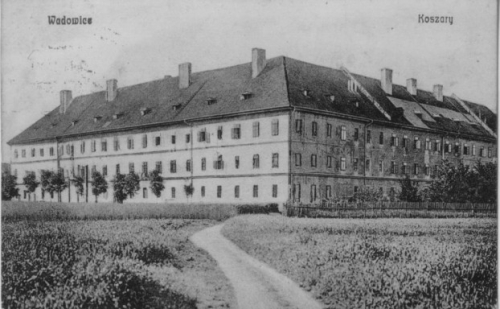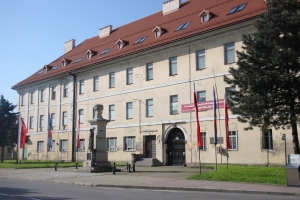He had short grey hair, and he was short. He used to wear pince-nez, i.e. type of rimless glasses. He implemented his profession of an officer into his family life - one could feel a certain discipline. He believed that it was necessary to spend the day piously and rationality. Every minute was calculated, used up. Time during the day was divided into prayer, meal, study and walk.
Eugeniusz Mróz - a middle school colleague
The military advantages of the town were noticed already at the turn of the 18th and 19th centuries. Immediately after the district office was moved to Wadowice, the first military units were moved here. The magnificent barracks building was built in the first half of the 19th century and it is a typical monument of military architecture of the former Austrian partition. It was built on a square plan with an inner courtyard surrounded by arcaded corridors. Until the end of World War II, it served as a garrison facility, and in later years it was used for various purposes.
Karol Wojtyła, the father of St. John Paul II, began his military career in these barracks. He was born in 1879 in Lipnik near Biała (today Bielsko-Biała). Already at the age of 14, Karol interrupted his education at the imperial and royal higher middle school and started working in his father's tailor's workshop.
In 1900, he reached the recruitment age (21 years) and began 3 years of service in the Imperial and Royal 56th Galician Infantry Regiment of Count J.L. Daun in Wadowice. When it came to an end, Karol Wojtyła decided to remain in the imperial and royal army as a professional clerical non-commissioned officer in the Poviat Army Recruiting Command (PARC, 1904). A year later he was transferred to the Regimental Adjutant's Office in Cracow, where he remained until 1913. He was responsible for preparing instructions, supervising the regiment's budget and correspondence. He was promoted to the rank of accounting non-commissioned officer for the fair performance of these duties.
During his stay in Cracow, Karol met and married Emilia Kaczorowska. The ceremony took place on 10 February 1906 in the garrison church of St. Apostles Peter and Paul. Young spouses settled in the village of Krowodrza near Cracow. Their first son, Edmund, was born the same year.
In 1913, Wojtyła became a military official and started working for the Poviat Army Recruiting Command in Wadowice and then, together with his wife and son, he moved to the town by the Skawa River.
When World War I broke out (1914), the imperial and royal army was mobilised, including the 56th regiment. As an official, Karol could not take part in the fights so he stayed in the barracks in Wadowice. In mid-November 1914, the battalion was evacuated to Moravia and he was moved with his family to the area near Hranice (today Czech Republic). After his return to Wadowice, he continued his office service in his original regiment until October 1918, when the Polish administration took over power in Galicia.
In February 1919, as a soldier of the Polish Army, Karol became the head of the Wadowice chancellery of the Poviat Army Recruiting Command. Then, he and his family moved to a flat in a tenement house at 7 Kościelna Street, where his second son, Karol Józef, was born in 1920. Two years later he became a professional officer in the recruiting service. Unfortunately, due to a serious illness of his wife Emilia, he took early retirement in 1927.
After the holidays of 1938, Karol and his son Karol Józef left Wadowice and moved to Cracow. Karol Wojtyła Senior died on 18 February 1941, after a short and severe illness, at the age of 62. The funeral took place at the Rakowicki Cemetery in Cracow on 22 February 1941, where he rested at the side of his beloved wife.


